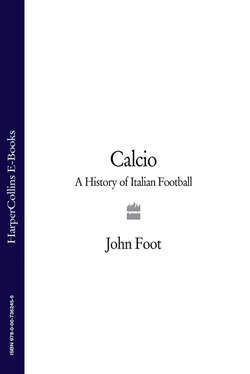Читать книгу Calcio: A History of Italian Football - John Foot - Страница 57
The Filadelfia Story. From Fortress to Ruin
ОглавлениеINTERVIEWER: ‘What do the other kids at school say when you tell them you support Torino?’
SMALL BOY: ‘They think I’m mad.’ (TV interview, 2005)
If you take the number fourteen tram in Turin, or just ask a taxi to leave you at the ‘old stadium’ in Via Filadelfia, not far from the city centre, you find yourself in front of a ruin. It is easy to get in through a hole in the red fence, next to the remains of some ticket offices. What you next see are the vestiges of one of the most loved and famous football stadiums in the world – the ‘Filadelfia’, home to the Grande Torino team. In 1948 Torino played nineteen home games here, winning eighteen of them. The pitch is still there, and there is even a goal with a broken crossbar. Beyond that, all that is left are a few strange pieces of stand – sticking up out of the grass like bizarre Roman monuments. Here and there you can see traces of the old stadium – signs, steps, barriers. Outside, the Torino fans have hung up a defiant sign – the Casa del Popolo Granata (Claret red home of the people) and a protest banner calling for No Housing on the Filadelfia.
Everything else, apart from one tower and a sparkling Torino emblem in stone on the front, has been demolished. Nonetheless, this is still a magical place that transmits a strong sense of history and tragedy. To walk on the field where Valentino Mazzola commanded play, rolling up his sleeves before ordering another attack, is to touch the very stuff of football legend. Torino fans can often be seen talking outside the ex-ground, or gathering in the Torino bars nearby. When journalist Massimo Gramellini organized a ‘March of Claret Red Pride’ in 2003, the starting point was at what he called ‘the ruins of the Filadelfia’. The old stadium, however, is also a source of shame – the ‘shame of all Turin’ as one fan’s website put it.
In 1926 the stadium opened with a 4–0 victory over Roma, in the presence of Prince Umberto (heir to the throne) and 15,000 spectators. It had an English-style design, with long stands and barriers. The spectators were extremely close to the pitch. Financed by the then Turin president Conte Enrico Marone di Cinzano the stadium stood on what was at that time the edge of the city, close to the FIAT factories which provided the bedrock of Torino support. Torino won their first championship here in 1928.
Torino’s great 1940s sides – Il Grande Torino – did not just beat teams, they destroyed them. Playing with the ‘method’ system made popular in England, Torino attacked – scoring goals almost at will, especially from midfield, and rarely conceding at the back. They were also fitter than other teams – often scoring late-on. President Novo took physical preparation very seriously, and employed an expert English coach – Leslie Lievesley – to deal with this side of the game in the late 1940s. In addition, Torino were a remarkable unit, friends on and off the field, a team who had lived through the trials and tribulations of the war. Torino could also count on the intimidating atmosphere of the Filadelfia stadium that no visiting team could cope with.
After Superga, Torino continued to play in the crumbling venue until 1963, when they began to share the nearby Comunale stadium with Juventus.28 Built in 1932–33, the Comunale was designed as a simple concrete bowl. It held almost 60,000 fans but lacked the intensity of the Filadelfia. The ex-‘Benito Mussolini stadium’ (renamed in 1945) was renowned for its enormous concrete tower, covered in lights – the Torre Maratona – with its huge sign saying STADIO. Torino played in the Comunale for 27 years, winning the championship there in 1975. The Comunale stood empty after 1990 – although Juventus continue to train there – while hundreds of turnstiles and ticket booths slowly rusted away.29
In 1990 both Turin clubs moved to yet another stadium, the Stadio delle Alpi, an impressive structure built for the World Cup of that year. However, it lies right on the edge of town – unlike the Comunale and the Filadelfia – and its athletics track (rarely used) and architecture make it hard to see the game properly from inside. Torino fans have had a dream for forty years – to return to regular games at a rebuilt Filadelfia. Many promises have been made over the years, and all of them have been broken.
